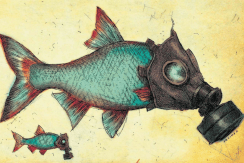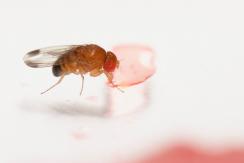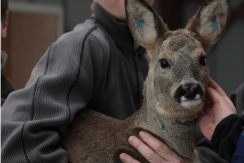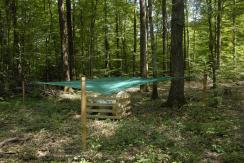Evolutionary Ecology
The department of Evolutionary Ecology gathers complementary skills in behavioural ecology, population dynamics, population biology, community ecology, and methodology (statistics and modelling). The research done in the department aims at studying how animal species evolve in a changing world by understanding the causes of the evolution of traits, adaptations and interactions. For that, we consider different levels of organization from individuals to populations and communities. Because organisms cannot be considered isolated from other biotic factors, we consider pathogens but also competing species within communities.
We study how individuals adapt to their environments that are largely impacted by anthropic pressures, and how life history traits and behaviour evolve in response to these pressures. Although we mainly focus on phenotype, we more and more consider the mechanistic link between the genotype and the phenotype. We develop the theoretical framework of our discipline through a conceptual and modeling approach. In parallel, we test hypotheses that arise from theoretical predictions through experimental, comparative and observational approaches on different biological models (insects, birds, mammals). Experimental approaches are developed in the laboratory (insect model) and in natura (bird, insect and mammal models). Observational and comparative research is mainly concerned with vertebrates. Our approaches are also, and increasingly, interested in the mechanisms of adaptive responses. In addition to the classical approaches of demographic analysis and trait change, methods of ecophysiology, chemical ecology and molecular biology are used.
Our department hosts several long-term studies of wild populations of different species. These long-term studies offer a valuable way to understand how biotic and abiotic factors affect individuals’ life history traits, and the functioning of populations in natura. Five populations of mammalian species are thus monitored for several years (more than 40 years on roe deer, 30 on Alpine marmots, 25 years on cats, 16 years on zebras, and 20 years on impala). Two of our study sites (La Sassière in Vanoise National Park (Alpine marmots) and Hwange National Park) have been certified as “Site d’Etude en Ecologie Globale” (SEEG), and two (ZA “Hwange” and ZA “Antarctic and sub-Antarctic”) were certified as “Zone Atelier” by the CNRS.
The department of Evolutionary ecology is also largely involved in training activities. Lastly, we also have strong socio-economic relationships. Indeed, because we address questions of major societal interest (global warming, public health) we tightly collaborate with socio-economic partners (Office Français de la Biodiversité, Vanoise National Park, Hwange National Park in Zimbabwe, Office National des Forêts, etc.) and participate to general public and media events.
Publications
Display of 1621 to 1650 publications on 2449 in total
Revisiting Guerry's data: introducing spatial constraints in multivariate analysis.
Annals of Applied Statistics . 5 ( 4 ) : 2278-2299
DOI: 10.1214/10-AOAS356
Journal article
see the publicationHunting Bambi - evaluating the basis for selective harvesting of juveniles
European Journal of Wildlife Research . 57 ( 3 ) : 565-574
Journal article
see the publicationRevisiting the allometry of antlers among deer species: male-male sexual competition as a driver
Oikos . 120 : 601-606
Journal article
see the publicationEffects of Satellite Transmitters Fitted to Breeding Cory's Shearwaters
Journal of Wildlife Management . 75 ( 3 ) : 709-714
DOI: 10.1002/jwmg.90
Journal article
see the publicationDevelopment of a sensitive method for Toxoplasma gondii oocyst extraction in soil.
Veterinary Parasitology . 183 ( 1-2 ) : 59-67
Journal article
see the publicationGenetic diversity of toxoplasma gondii strains from two different environments in French Guiana : wild versus anthropized.
Microorganisms facing their environment - muséum National d'Histoire Naturelle .
Conference paper
see the publicationGenetic diversity of Toxoplasma gondii strains from two different environments in French Guiana: wild versus anthropized.
11th International Toxoplasma Meeting .
Conference paper
see the publicationL'impact humain sur la diversité génétique de Toxoplasma gondii : exemple de l'environnement anthropisé de la Guyane française.
Congreès SFMM, SFP, GPLF (Communication orale) .
Conference paper
see the publicationSocial cues of sperm competition influence accessory reproductive gland size in a promiscuous mammal
Proceedings of the Royal Society B: Biological Sciences . 278 : 1171-6
Journal article
see the publicationBiogeographical patterns of soil molecular microbial biomass
Ecology of soil microorganisms : microbes as important drivers of soil processes . : 1 p.
Conference paper
see the publicationDiversity Geographic Distribution and Habitat-Specific Variations of Microbiota in Natural Populations of the Chicken Mite Dermanyssus gallinae
Journal of Medical Entomology . 48 : 788-796
Journal article
see the publicationInsertion Sequences as Highly Resolutive Genomic Markers for Sequence Type 1 Legionella pneumophila Paris
Journal of Clinical Microbiology . 49 ( 1 ) : 315-324
DOI: 10.1128/JCM.01261-10
Journal article
see the publicationHuman impact on genetic diversity of Toxoplasma gondii: example of the anthropized environment from French Guiana.
Infection, Genetics and Evolution . 11 ( 6 ) : 1378-87
Journal article
see the publicationEvolution of molecular error rates and the consequences for evolvability
Proceedings of the National Academy of Sciences of the United States of America . 108 ( 3 ) : 1082-1087
Journal article
see the publicationSoil fungal communities ecology: a biogeographical approach
Ecology of soil Microorganisms Conference . : 1 p.
Conference paper
see the publicationHow non-standard test methods and data analysis tools can benefit to ecological risk assessment of chemicals ?
21. SETAC Europe annual meeting "Ecosystem protection in a sustainable world : a challenge for science and regulation" .
Conference paper
see the publicationWhere do fishmeal and fish oil products come from? An analysis of the conversion ratios in the global fishmeal industry
Marine Policy . 34 ( 4 ) : 815-820
Journal article
see the publicationContribution à l'étude des communautés d'adventices des culture du secteur phytogéographique oranais (Nord-ouest algérien) : aspects botanique, agronomique et phyto-écologique
AFPP - 21e Conférence du COLUMA - Journées internationales sur la lutte contre les mauvaises herbes . : 1-10
Conference paper
see the publicationCreationist conceptions of primary and secondary school teachers in nineteen countries
Contemporary Science Education Research: International Perspectives . 9786053640318 : 447-452
Book chapter
see the publicationTransfer of hydrophobic contaminants in the Rhône River from the sediment to the biota: development of a bioaccumulation model in a management perspective
SETAC Europe . : 2
Poster
see the publicationMachupo Guanarito Sabia and Chapare Viruses
incollection . 68 : 747-757
Journal article
see the publicationDéterminisme de l’impact des pesticides en cours d’eau : influence de la dynamique de l’exposition sur les effets biologiques
Colloque de restitution du programme EC2CO . : 1
Poster
see the publicationPopulation level integration of individual effect measurements for in situ water quality assessment: a modelling approach with Gammarus fossarum
14th international colloquium on Amphipoda . : 1
Poster
see the publicationCoupler modèles de dynamique de population et encagements in situ pour appréhender les effets populationnels des contaminations : illustration de la démarche chez le crustacé Gammarus fossarum
Ecologie 2010 . : 25
Conference paper
see the publicationA temperature-dependent Leslie model to describe the dynamics of a bullhead (Cottus gobio) population
Conference on Computational and Mathematical Population Dynamics . : 1
Conference paper
see the publicationModelling and in situ caging for a realistic extrapolation of ecotoxicological effects at the population level: a methodological approach with Gammarus fossarum (Crustacean) and Potamopyrgus antipodarum (Gastropod)
20th SETAC annual meeting . : 24
Conference paper
see the publicationPopulation dynamics and integration of individual toxicological effects for in situ water quality assessment: a modelling approach with Gammarus fossarum and Potamopyrgus antipodarum
Colloque de la SEFA . : 1
Poster
see the publicationApplication of a temperature-dependent von Bertalanffy growth model to bullhead (Cottus gobio)
Ecological Modelling . 221 ( 20 ) : 2475-2481
Journal article
see the publicationSerological evidence for the presence of non-pathogenic rabbit haemorrhagic disease virus-like strains in rabbits Oryctolagus cuniculus of the Kerguelen archipelago
Polar Biology . 33 ( 7 ) : 985-989
Journal article
see the publicationModelling the effect of temperature on transmission of dengue
Medical and Veterinary Entomology . 24 ( 1 ) : 66-73
Journal article
see the publication





You also, comment on this article